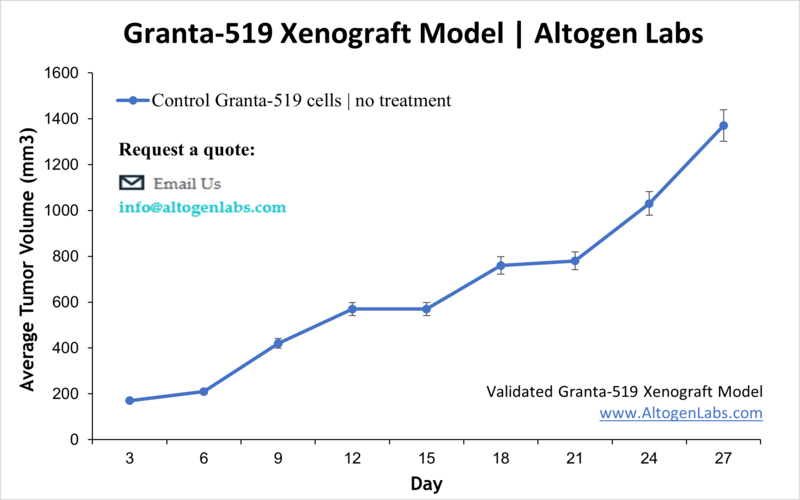
Granta-519 Xenograft Model
Lymphoma is a cancer group which affects lymphocytes, a subtype of white blood cell. Symptoms of lymphoma include fever, sweats, itching, fatigue, enlarged lymph nodes and weight loss. Risk factors include HIV/AIDS, autoimmune diseases, smoking tobacco, and the Epstein-Barr virus. The two main types of lymphoma are 1) Hodgkin’s lymphoma and 2) non-Hodgkin lymphoma (NHL). The 5-yr survival rate in the United States is 85%. Mantle cell lymphoma (MCL) is in the NHL class and is extremely rare (6% of NHL cases). The Granta-519 cell line was first isolated from a 70 year old Caucasian male originally diagnosed with chronic lymphocytic leukemia (CLL) that transformed approximately 2 years later into B-cell aggressive acute lymphocytic leukemia. Because the neoplasms had blastoid transformations present, it was then reclassified as mantle cell lymphoma, known to affect cells of the mantle zone surrounding germinal center follicles. Since its isolation Granta-519 cells have been used in a multitude of studies. Wenqing et al. (Biochemistry Pharmacology 2011) used Granta-519 as a non-Hodgkin mantle cell lymphoma model in order to study the aurora A and B (overexpressed in MCL) inhibitor MLN8237. Results demonstrated that MLN8237 successfully induced apoptosis and in combination with docetaxel had significant tumor growth inhibition in xenograft models. This shows promise for the use of this combination therapy in refractory/relapsed aggressive B-cell NHL. In 2016, Akhenblit et al. (Molecular Imaging) used Granta-519 cells for their activated mTOR pathway. The group used mTOR inhibitor everolimus (RAD 001) and used an AcidoCEST MRI technique to monitor the extracellular pH (pHe) as a marker for effective therapy response. Results demonstrated that acidoCEST can successfully measure pHe which is correlated to decreased tumor growth. Lastly, a Leukemia Lymphoma study (Verner et al. 2015) established xenografts with immunodeficient NOD/SCID IL2Rγ-null (NSG) mice and the ATM-mutated mantle cell lymphoma model Granta-519. Results demonstrated that Granta-519 cells displayed massive infiltration into other organs and bones regardless of transplantation route. This data verifies the use of Granta-519 for in vivo xenograft studies of chronic lymphocytic leukemia. The Granta-519 cell line is used to create the CDX (Cell Line Derived Xenograft) Granta-519 xenograft mouse model. The Granta-519 xenograft model has been used as a model for aggressive/late stage NHL studies investigating potential treatment strategies (ex. aurora inhibitor MLB8237, mTOR inhibitor everolimus).
Basic Study Design
- Granta519 cells are maintained in exponential growth phase under aseptic conditions.
- Cells are trypsinized and cell count viability is determined using a trypan blue exclusion assay (98% of cell viability is required). Granta-519 cell suspension is adjusted to appropriate density.
- Each mouse is singly subcutaneously injected into the right flank with 106 cells in 100-200 µL of a Matrigel-Granta519 cells suspension.
- The injection sites are palpated up to three times weekly until tumors are established to an average size of 100-150 mm3 as measured via digital calipers.
- Animals are randomized into treatment groups. Administration of test compound is performed according to the pre-established treatment schedule.
- Mice weights are measured and recorded 3 times weekly; tumors are measured and recorded daily.
- End of study is reached when tumor size reaches 2,000 mm3 or the predetermined size limit per approved IACUC protocol.
- Final necropsy and tissue collections are performed for appropriate downstream analysis. Tumors are excised, weighed and documented by digital imaging. Tumors and tissues can be stabilized in RNAlater, snap frozen in liquid nitrogen or prepared for histology.
